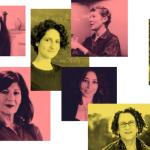19 Women Leading Math and Physics

In an interview with Quanta Magazine last fall, the eminent theoretical physicist Helen Quinn recalled her uncertainty, as a Stanford University undergraduate in the 1960s, about whether to pursue a career in physics or become a high school teacher. “There were no women in the faculty at Stanford at that time in the physics department,” Quinn said. “I didn’t see myself there.” Her adviser warned her that “graduate schools are usually reluctant to accept women because they get married and they don’t finish.” (He kindly added that “I don’t think we need to worry about that with you.”)
In the 1970s, the Italian-American dark matter physicist Elena Aprile survived male advisers with a similar unwillingness to tolerate competing demands on her time. “It made me of titanium,” she said of her relationship with her brilliant but demanding mentor. “He would keep pushing you beyond the state that is even possible: ‘It’s all about the science; it’s all about the goal. … You have a baby to feed? Find some way.’”
Four decades later, the welcome mat can still be hard to locate. “In my entire career I’ve always been aware of being a woman in physics,” the theoretical astrophysicist Katherine Freese told Quanta in 2014. When she moved to Sweden that year to head up the Nordic Institute for Theoretical Physics, she was drawn to the cultural acceptance of women in science there. “On the entire planet, as far as I can tell, the best place for a woman to do science is Scandinavia,” she said.
The pipeline of women pursuing mathematics and physics is still dreadfully leaky. Because there are so few women in senior positions, aspiring researchers lack female mentors, perpetuating a sense of not belonging. In a recent interview, the French mathematician Sylvia Serfaty said that in her field “the numbers over the last 20 years are not a great improvement, sometimes even decreasing.” Serfaty, a prize-winning expert on vortex dynamics, argues that it hurts mathematics: “It’s good to have a diversity of frames of mind” when pursuing proofs, she said, “and women do tend to think a little bit differently.”
Some who achieve greatness prefer research over being a role model. The Iranian-American mathematician Maryam Mirzakhani, who became the first female Fields Medalist in 2014, told Quanta at the time that although the strength and encouragement of her female high school principal influenced her greatly, she had no desire to be the face of women in mathematics.
In addition to featuring these perspectives, Quanta has interviewed and profiled other top mathematicians and physicists who happen to be women. In honor of International Women’s Day and women everywhere, we’re sharing some of their stories here:
- The brilliant, vivacious physicist Sharon Glotzer is a modern-day “digital alchemist” seeking the rules by which complex structures emerge from simple building blocks. Glotzer runs a factory-size research group at the University of Michigan that keeps growing because she finds it impossible to turn away new students when she can tell “they’re nerds like us.”
- Gabriela González is a leader of the 1,000-person LIGO scientific collaboration that last year announced its discovery of gravitational waves.
- Like Aprile, the theorist Tracy Slatyer of the Massachusetts Institute of Technology is striving to understand dark matter. Last year, she explained how she discovered new features of the galaxy instead.
- The particle physicist Janet Conrad, meanwhile, is hunting for hypothetical particles called sterile neutrinos, which she anthropomorphizes as “little beasts” with strong personalities. All particles have them: “The quarks are the mean girls,” she said. “They’re stuck in their little cliques and they won’t come out. The electron is the girl next door. She’s the one you can always depend on to be your friend — you plug in and there she is, right?”
- Suchitra Sebastian explores exotic quantum phenomena that have “the potential to revolutionize the world.” Her unconventional path to the Cambridge University physics department included an M.B.A. and a job in industry. “I really need to be engaged with everything around me in different ways. How does the world work, how does economics work, how do governments run? I’m interested in the social implications of what we do,” she said.
- The astrophysicist, writer and event host Janna Levin has a similar ethos. “Science is just an absolutely intrinsic part of culture,” said Levin, who never graduated from high school and writes award-winning novels when she isn’t researching black holes.
- Miranda Cheng, another high-school dropout turned physicist-mathematician, is now chasing a mysterious connection between string theory, algebra and number theory.
- The Princeton University mathematician Maria Chudnovsky’s breakthroughs in graph coloring helped her arrange the seating chart at her wedding.
- The Ukrainian mathematician Maryna Viazovska solved the centuries-old sphere packing problem in higher dimensions. “It’s stunningly simple, as all great things are,” another researcher said of Viazovska’s proof.
- Laura DeMarco and Kathryn Lindsey are working to fold fractals into 3-D objects as a way of classifying simple equations.
- Kathleen Fisher and Jeanette Wingare leading the charge to develop formally verified, “hacker-proof” code.
- The computer scientist Cynthia Dwork is working to translate concepts like privacy and fairness into algorithms.
Now that you’ve read these stories, we’d love to hear yours in the comments section below.
